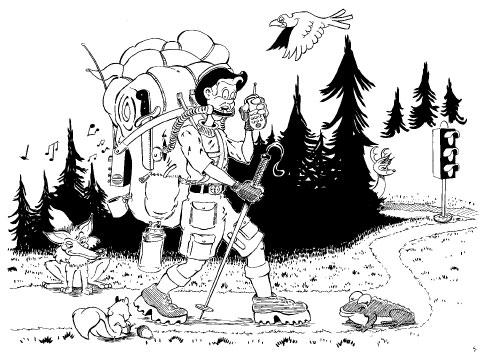When All Hell Breaks Loose (97 page)
Read When All Hell Breaks Loose Online
Authors: Cody Lundin

"The ladies have to go first. . .Get in the lifeboat, to please me. . .Good-bye, dearie. I'll see you later."
—John Jacob Astor, after putting his pregnant wife on one of the last lifeboats available from the
Titanic
T
he World Health Organization (WHO) estimates that from 1900–1988, hurricanes left more than 1.2 million people without homes and directly affected the lives of nearly 4 million people. Floods affected another 339 million people and left 36 million homeless. Earthquakes, cyclones, and typhoons each affected 26 million people, leaving 10 million more without a home.
Although this is a home-centered book on self-reliance, statistics such as these prove that an emergency can quickly leave you homeless. I realize leaving your home, by choice or by force, will be an excruciating decision to have to make but remember,
you are trying to save your body and those whom you love, not material possessions
. If you're dumb enough to get killed because you refused to leave your stuff, you win the Darwin award and the planet's gene pool inches up a notch. I don't mean to discount the emotional and mental pain of having to leave your home—I know it's scary—but you need to remind yourself of your survival priorities, that it's YOU that you're trying to keep alive. Material wealth and comfort don't mean squat to a corpse.

Whether your family stays put or evacuates will depend on many factors. Such factors might be forced upon you by governmental agencies, approaching floods, hurricanes, and a bevy of scenarios worthy of a Hollywood movie. In any event, you should take the concepts presented in this book regarding shelter, food, water, lighting, etc., and adapt them to what is commonly referred to as a "bug-out" pack. A bug-out pack, not unlike a wilderness survival kit, contains within it a distillation of the most important gear your family will need during its emergency, all in one portable container. This pack should be fully loaded and ready to go
before
it's needed so you can grab it at a moment's notice in case of an evacuation. The concept of the bug-out pack can be used in your car or office as well. You might have two or three bug-out packs. Paranoid? No, just smart. Having all of your eggs in one basket has been a bad idea from the beginning. As much as I love my self-reliant house, there is no guarantee that I'll be home watching cheap pawnshop videos when the fan blades turn brown.
Consider building a family bug-out kit
first, before
outfitting your home. As this pack is portable, its volume will severely limit your ability to fill it with frivolous junk. You will be forced to pare things down to the bare minimum, packing only what your loved ones truly need to deal with their emergency. This forced, minimalist mind-set will train your psyche to define more clearly your needs from your wants, something that has to be continuously guarded against in our consumer society. After reading this book, and reflecting upon the basic intentions recommended, design your kit using the recommendations, dovetailed with your family's situation. When you begin to outfit your home with self-reliant goodies, simply purchase more of the same stuff that you packed within your portable disaster kit.
Basic Bug-Out Kits
WHETHER YOU FIND YOURSELF IN AN URBAN OR WILDERNESS ENVIRONMENT, THE MORE YOU KNOW ABOUT ADAPTING YOUR SURROUNDINGS TO MEET YOUR NEEDS FOR SURVIVAL, THE BETTER OFF YOU WILL BE.
The core intention of the contents of a bug-out pack is not unlike the motive of a wilderness backpacker. The modern backpacker carries whatever gear they think will meet their needs within a remote, backcountry setting. Some of this gear is necessary for survival, like proper clothing in cold weather, and some of it is fluff, like the portable espresso coffeemaker. As most outdoor enthusiasts are unfamiliar with using the natural landscape to meet their needs, the backpack becomes a scuba tank, so to speak. The backpacker can live in the ocean of the wilderness for only as long as the supplies in his or her backpack will let them. When supplies run low, they are forced to resurface back at the nearest trailhead or vehicle for resupply. Whether you find yourself in an urban or wilderness environment, the more you know about adapting your surroundings to meet your needs for survival, the better off you will be. Like the wilderness survival kit, all items within your bug-out kit should follow strict guidelines as to their usefulness in the environment you'll find yourself. Some items will be of equal value regardless of where you are on the planet, such as potable water. Gear that supports your family's basic physiological survival should be given the first consideration. That said, you may have family members who will function much better when allowed to have along some psychological comfort item. The teddy bear does not replace the coat in cold weather, but we have already discussed how a person's psychology can and does readily influence their physiology. As with all things, use common sense.

Preparing Your Bug-Out Kit
Below is a list of concepts you should consider when deciding what to pack in your bug-out kit. Some of the information was borrowed from my first book,
98.6 Degrees: The Art of Keeping Your Ass Alive!
In it, for those who want more detailed information on survival kits, I devote the second half of the book to describing in detail what I carry for desert and mountain regions. If the list of recommendations below seems anal retentive, remember that it's often a combination of little mistakes that kill people.
Your bug-out kit should be:
Relevant to the environment encountered
Lightweight and portable
Waterproof
Durable and dependable
Complementary to the physical fitness and expertise levels of the user(s)
Able to meet a wide variety of conditions
Comprised of multiple-use components
Comprised of calorie-conserving components
Panic-proof—containing components that can be utilized if you are injured
Comprised of components that can be easily purchased or made
Obtainable,
yet invisible
Affordable, yet effective
Field-tested
Simple!